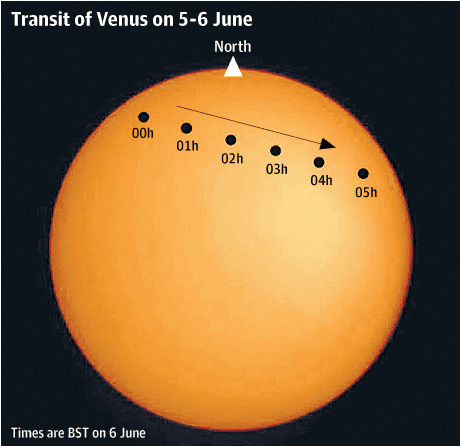Britain is poorly placed for views of the astronomical highlight of 2012, but the situation is not hopeless. To see the whole of the transit of Venus across the Sun's disc on June 5-6, though, it is not too late to travel eastwards, perhaps to areas around the W Pacific. If we are quick enough, we could even take in the annular eclipse of the Sun which begins over E China and Hong Kong next Monday morning, local time, and ends (after crossing the date line) on Sunday evening over the SW USA.
Venus is an outstanding evening star to the N of W at nightfall tonight, its altitude at sunset falling to 15° by the 22nd when it stands above the slimmest of young moons. We probably lose it in the twilight a week later and after another week its inky black disc crosses the N part of the Sun as shown by our diagram.
Seen from the direction of the Earth's centre, Venus first touches the Sun's NE limb at 23:10 BST on 5 June, is farthest on to the disc at 02:30 on the 6th and finally leaves the WNW limb at 05:49. In fact, these times vary by up to 6 minutes depending on our location on the Earth; as seen from much of Britain, for example, Venus does not disappear from the Sun until 05:55.
Britain's problem is that most of the transit occurs before the Sun rises above our NE horizon. For example, sunrise for London, Cardiff and Belfast occurs at 04:45, 04:58 and 04:51 respectively. Scotland, particularly N and E Scotland, fares better, with sunrise for Edinburgh coming at 04:30. As the transit ends, the Sun stands 8° high as seen from London and 9° high for Edinburgh.
Even though the Sun is low in the sky, serious eye damage is likely if we look directly at it through a telescope or binoculars. Instead, project the Sun's image through the eyepiece on to a white card or obtain an approved solar filter to block the Sun's heat and intense light before it enters the optics.
The fact that the time of a transit varies worldwide was of major interest during the 18th and 19th centuries, for exact timings could be used to triangulate the distance to Venus, and hence the scale of our solar system. Expeditions to far-off locations to secure observations included the first voyage by James Cook who timed the transit of 1769 from Tahiti.
Part of the romance of such events is their rarity; there have been only three transits since Cook's venture, those of 1874, 1882 and 2004. Britain, at least those parts without too much cloud, witnessed the whole of the 2004 event but we need to wait until 2247 for an equally-favourable one. Before then there are transits in 2117, which occurs in the middle of a winter's night for Britain, and 2125 when the Sun sets at about mid-transit.

Comments (…)
Sign in or create your Guardian account to join the discussion